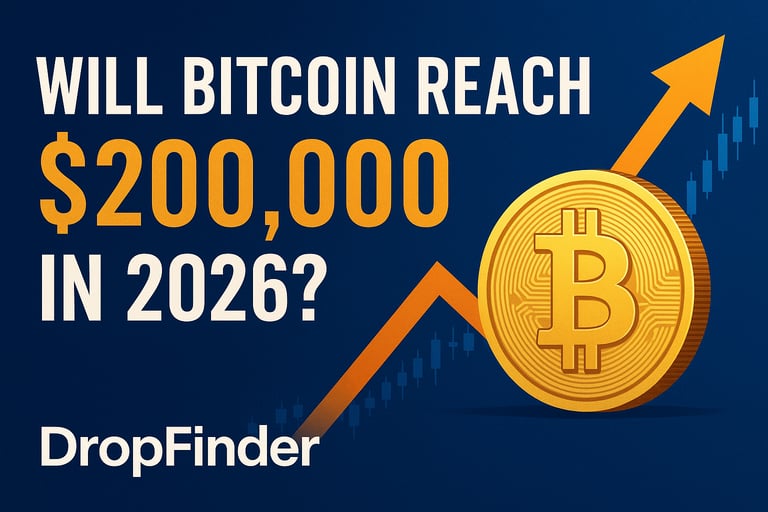Will Bitcoin Reach $200,000 in 2026? The Ultimate Crypto Forecast by DropFinder
Can Bitcoin hit $200K by 2026? Explore DropFinder’s deep analysis on BTC’s next halving cycle, market psychology, ETF inflows, and macro forces shaping the next crypto bull run.
CRYPTO NEWS
11/11/20257 min read
Will Bitcoin Reach $200,000 in 2026? A Deep Dive by DropFinder
Bitcoin has evolved from a revolutionary concept into a financial superpower. From a price under a dollar to nearly $70,000 in 2021, it has repeatedly redefined the global wealth landscape. As we head toward 2026, a key question dominates every crypto investor’s mind — can Bitcoin really reach $200,000?
In this exclusive DropFinder deep dive, we’ll explore Bitcoin’s four-year cycle, institutional demand, macroeconomics, on-chain data, and investor psychology to uncover whether $200K BTC is truly within reach.
1. The Four-Year Halving Blueprint
Every Bitcoin bull run follows one powerful principle — the Halving.
A Bitcoin halving happens roughly every four years, cutting miners’ rewards in half and drastically reducing new supply. This scarcity effect has historically triggered massive rallies within the following 12 to 18 months.
In 2012, Bitcoin’s first halving sent the price from $12 to over $1,000.
In 2016, it went from around $650 to nearly $20,000.
In 2020, it climbed from $8,600 to $69,000.
Each time, supply shock met growing demand, and the price multiplied.
Following the same pattern, even a conservative 3x growth from the 2024 post-halving base near $65,000 puts Bitcoin around $195,000 — almost exactly at the $200K mark.
DropFinder’s research shows that cycle tops generally arrive 12 to 18 months after halving events, meaning late 2025 to mid-2026 could be the perfect window for the next Bitcoin peak.
2. Institutional Money: The 2024–2026 Game Changer
This cycle is unlike any before it because for the first time, Wall Street is all in.
Bitcoin ETFs: Opening the Floodgates
The approval of spot Bitcoin ETFs from giants like BlackRock, Fidelity, and ARK completely changed market dynamics. Institutions that were once restricted by compliance barriers can now gain exposure to Bitcoin through regulated funds.
By the end of 2025, these ETFs collectively held over a million BTC. Even if only 1% of global wealth shifts into Bitcoin via ETFs, that translates to more than $500 billion in demand — enough to push Bitcoin’s market cap above $4 trillion. At that valuation, the price naturally surpasses $200,000 per coin.
Corporate Treasuries and Governments Join In
Corporations like MicroStrategy and Tesla already hold Bitcoin, but the next frontier could be national adoption. El Salvador’s success story inspired countries like Argentina to explore partial Bitcoin reserves.
If governments start treating Bitcoin like digital gold, 2026 could mark a financial revolution — and $200,000 could become the new benchmark, not the ceiling.
3. The Macro Setup: Inflation, Debt, and Fiat Fatigue
Bitcoin was created in response to the failures of the fiat system — and those failures are now more visible than ever.
The Global Debt Crisis
Global debt has surpassed $320 trillion, while central banks keep printing money to service it. Every time more fiat is printed, Bitcoin’s limited supply narrative strengthens.
Bitcoin’s hard cap of 21 million coins makes it the most deflationary asset in existence. In a world of endless money printing, Bitcoin’s scarcity could drive historic demand.
The Dollar’s Weakening Grip
The Federal Reserve’s aggressive rate hikes cooled inflation temporarily, but by 2025–2026, rate cuts and renewed liquidity could once again flood markets with cash. Historically, Bitcoin thrives in such environments.
De-Dollarization and BRICS Influence
Global powers like China, Russia, and Brazil are moving away from dollar settlements, exploring gold and digital currencies instead. Bitcoin, being borderless and politically neutral, fits perfectly into this new world order. DropFinder’s analysts believe this trend will provide the macro push needed for Bitcoin’s next explosive move toward $200,000.
4. On-Chain Data Confirms the Bullish Case
Numbers often reveal what words can’t, and Bitcoin’s on-chain metrics are painting a bullish picture.
The amount of Bitcoin held on exchanges has dropped to just around 6% of the total supply — the lowest level ever recorded. This indicates strong accumulation by long-term holders and institutional wallets.
Meanwhile, wallets holding more than 1,000 BTC are increasing steadily, showing that whales and funds are stockpiling ahead of the next rally.
Post-halving, miners produce only 450 BTC per day, while ETF inflows are absorbing five times that amount. The result is a severe supply shortage. When demand outpaces supply by this magnitude, price adjustments are inevitable — and almost always upward.
5. Market Psychology and the Human Factor
Every Bitcoin cycle follows a psychological pattern: disbelief, hope, optimism, belief, and finally euphoria.
Right now, in late 2025, the market is transitioning from belief to euphoria. Institutions are buying, the media is returning to bullish coverage, and retail investors are waking up again.
If the pattern repeats, the euphoria phase — expected around 2026 — could easily take Bitcoin to the $200,000 mark. This is the same psychological setup seen before the 2013, 2017, and 2021 peaks.
DropFinder’s cycle models indicate that we’re still in the expansion stage, with the most aggressive price action yet to come.
6. Bitcoin’s Technological Evolution
Beyond price speculation, Bitcoin’s infrastructure is becoming more advanced than ever.
The Lightning Network enables instant, low-cost Bitcoin transactions worldwide, solving scalability concerns. Layer-2 innovations like Stacks and RSK are transforming Bitcoin into a programmable settlement layer for smart contracts, NFTs, and DeFi.
Meanwhile, mining is becoming greener and more efficient, with increasing use of renewable energy and methane capture. As sustainability improves, institutional investors gain more confidence to allocate funds to Bitcoin.
These technological improvements strengthen Bitcoin’s long-term legitimacy, attracting both retail and corporate players — a key ingredient for reaching $200,000.
7. Comparing Bitcoin to Gold
Bitcoin is frequently called “digital gold,” and for good reason. Both are scarce, divisible, and decentralized, but Bitcoin is more portable and transparent.
Gold’s market capitalization is around $14 trillion. Bitcoin’s is about $1.3 trillion.
If Bitcoin captures just 20% of gold’s market, that implies a $2.8 trillion valuation and a price of roughly $135,000 per BTC. At 30–40% parity, Bitcoin would easily trade above $200,000.
With younger generations favoring digital assets over physical metals, this shift seems inevitable. DropFinder’s research projects that by 2026, Bitcoin could capture up to one-third of gold’s store-of-value market — enough to make the $200K prediction a reality.
8. The Power of Emerging Markets and Retail Adoption
While institutions drive early momentum, retail investors ignite the mania phase.
Thanks to the global accessibility of crypto apps and exchanges, billions of people can now buy Bitcoin directly from their smartphones. In nations like Nigeria, Argentina, and Turkey, citizens use Bitcoin daily as protection against inflation and currency collapse.
As these trends spread across Asia, Africa, and South America, the combined retail inflow could rival — or even surpass — institutional demand. This democratization of access is a crucial force pushing Bitcoin closer to $200K.
9. Technical Models Point Toward $200K
Several technical models predict Bitcoin’s next top in the $190K to $250K range.
The Stock-to-Flow (S2F) model, which measures scarcity, projects an average price of $250,000 for this halving cycle. While it has faced criticism, its long-term accuracy remains notable.
Elliott Wave analysis suggests Bitcoin is in its fifth and final impulsive wave — a stage that historically ends with euphoric peaks. Fibonacci extensions from the 2022 low of $15,500 and the 2024 breakout above $70K point directly toward the $190K to $210K range.
Together, these indicators form a powerful confluence around $200,000 as the likely top.
10. DropFinder’s Forecast for 2024–2026
According to DropFinder’s predictive models, the Bitcoin roadmap unfolds in clear phases:
From early to mid-2024, Bitcoin accumulates between $55,000 and $75,000 as ETF demand builds.
In late 2024 through early 2025, expansion accelerates toward $140,000.
By mid-2025 to mid-2026, euphoria dominates, potentially driving prices between $160,000 and $230,000 before a correction.
DropFinder assigns a 70% probability that Bitcoin will touch or surpass $200,000 between March 2025 and June 2026, based on institutional inflows, supply cuts, and macro liquidity trends.
11. Risks and Realities
While the $200,000 scenario is plausible, it’s not guaranteed.
Regulatory crackdowns could slow adoption, especially if governments impose heavy taxes or restrictions. Unexpected black swan events — like exchange collapses, hacks, or geopolitical tensions — could trigger panic selloffs.
And even if Bitcoin hits $200,000, history shows it often retraces 40–60% after euphoric peaks. The key is long-term conviction rather than emotional reaction.
DropFinder reminds investors that volatility isn’t a flaw — it’s opportunity. Smart accumulation during downturns has historically been the difference between traders and millionaires.
12. How Investors Can Prepare
To navigate the road to 2026 wisely, DropFinder recommends a few key strategies.
Adopt dollar-cost averaging. Buy Bitcoin consistently over time instead of chasing short-term tops.
Track on-chain data regularly. DropFinder’s analytics tools can help monitor whale accumulation, ETF inflows, and supply trends.
Diversify within crypto. While Bitcoin is the anchor, pairing it with Ethereum, Solana, or promising Layer-2 projects can enhance portfolio performance.
Recognize the signs of euphoria. When mainstream media starts predicting “Bitcoin to $1 million,” that’s the time to consider partial profit-taking.
These steps help investors stay rational during the chaos of bull markets.
13. Why DropFinder Believes in $200K
DropFinder was founded on one mission — to identify trends before they go mainstream.
Bitcoin’s path to $200,000 isn’t driven by hype, but by math and macroeconomics. The convergence of four key forces — limited supply, global adoption, institutional legitimacy, and monetary expansion — forms the foundation of this belief.
As one DropFinder analyst summarized it:
“Bitcoin hitting $200K isn’t a dream. It’s what happens when digital scarcity meets human greed on a global scale.”
14. What Happens After $200K
If Bitcoin reaches $200,000, its market capitalization would approach $4 trillion — half that of gold. At this point, Bitcoin would no longer be viewed as a speculative asset but as a global reserve asset in the making.
This milestone would likely attract sovereign wealth funds, pension funds, and even central banks, marking the true institutionalization of Bitcoin.
However, every bull run is followed by a correction. Prices may retrace to $120K–$150K post-peak before stabilizing. For long-term holders, this will simply be the beginning of Bitcoin’s next chapter — one where $200,000 becomes the floor, not the ceiling.
Conclusion
Bitcoin has always moved in four-year chapters — each ending with disbelief, mania, and a new definition of value.
The 2024 halving has set the stage, institutional adoption has supplied the capital, and global economic shifts are adding fuel to the fire. All evidence points to one reality: Bitcoin has never been better positioned to rewrite financial history again.
While nobody can predict the exact top, all major indicators — from on-chain metrics to macro liquidity — suggest that $200,000 Bitcoin in 2026 is not just possible but increasingly probable.
DropFinder continues to monitor these patterns, offering investors real-time insights into the trends shaping crypto’s next great surge.
So, will Bitcoin hit $200,000 in 2026?
If history rhymes — and it always does — the answer is yes. The question isn’t if Bitcoin reaches $200K, but when you’re ready to ride the wave.




